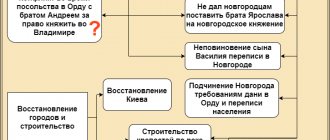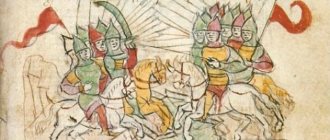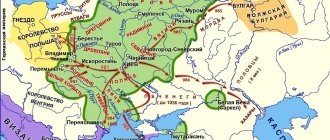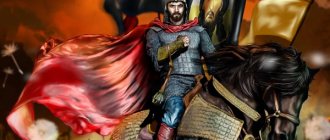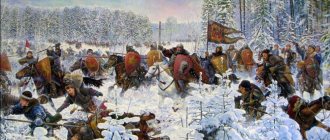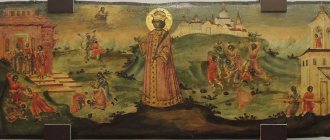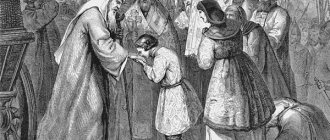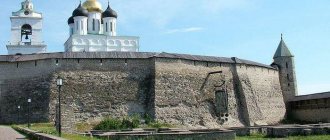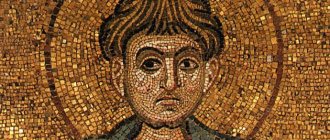short biography
Prince Dmitry Donskoy, portrait from the "Tsar's Titular Book" of the 17th century
Dmitry Ivanovich Donskoy - ruler of the Moscow principality from 1359 to 1389, Grand Duke of Vladimir from 1363, son of Ivan II the Red and grandson of Ivan I Kalita. He is one of the most famous rulers of Muscovite Rus' during the Mongol-Tatar yoke due to his victory over the Golden Horde temnik Mamai in the Battle of Kulikovo in 1380 - the first major battle of Russian troops with the Horde, the success of which became an important step towards strengthening the Moscow principality and future overthrow Golden Horde yoke. After the invasion of Tokhtamysh in 1382 and his devastation of the capital, Donskoy had to resume paying tribute to the Horde, but Moscow had already become not only the center of unification for numerous appanage principalities, but also the strongest economic player in the region (large-scale construction of temples and monasteries was carried out, coinage was resumed after a 250-year break).
In the confrontation with Lithuania for influence on Tver, Prince Dmitry withstood the siege of Moscow twice and was even able to make peace for some time with the Lithuanian Prince Olgerd on the condition of the latter’s non-interference in Tver affairs. However, soon control over Tver was lost - in 1382-1383, Tokhtamysh received tribute from Donskoy for the two years that had passed since the defeat of Mamai and secured the right to the reign of Vladimir for the Moscow Rurik dynasty, while simultaneously giving the Tver principality independence from Moscow. Since 1386, the Principality of Lithuania extended power to Smolensk.
Lithuania
This is how, according to documentary archives of the 15th century (Rogozhsky chronicler), the large-scale military campaign of Prince Olgerd against the Moscow principality was called.
It is interesting that at the initial stage of the confrontation, the Lithuanian and Russian princes acted with the wrong hands. By the mid-60s, a territorial dispute flared up in the Tver lands between princes Mikhail Alexandrovich and Vasily Kashinsky.
The Moscow rulers sided with the latter. Formally, he was supported by Dmitry Donskoy himself, who at that time, however, was not an independent figure.
The Lithuanian prince Olgerd stood up for Mikhail Alexandrovich. The situation has become dangerously tense. Very soon, Kashinsky and his loyal people besieged Tver, stood under the walls of the city, but could not take it.
Prince D. Donskoy
Mikhail Alexandrovich enlisted the support of the Lithuanians and recaptured Tver. However, he did not go any further.
In 1968, Moscow rulers invited the Tver prince to their lands. But as soon as he accepted the invitation, he was captured. Only thanks to the arrival of Horde officials, Mikhail Alexandrovich managed to get out of the hands of the Moscow rulers. He hastily left for Lithuania.
The Lithuanians' response to the attempt to eliminate their protege was the first campaign. It was headed by Olgerd. The attack was unexpected both in timing and direction.
On the way to the Moscow lands, the Lithuanians took several cities and won a number of convincing victories. Olgierd did not receive any serious resistance.
Very soon the Lithuanians stood under the walls of Moscow. The three-day siege did not bring results. It is not known how Olgerd’s first campaign would have ended if he had not received news of the attack on the country of the Teutonic Order. The foreigners went home, but took a lot of valuables, livestock and stole many captives.
Dmitry Donskoy with his army
The retreat of the Lithuanian troops was more like a raid: they destroyed everything that came in their way. In response, princes loyal to Moscow made several raids on enemy-occupied lands: Smolensk, etc. But it was impossible to keep them. Such attacks ended in nothing.
Dmitry Donskoy realized that there was no way to openly confront Tver and the Lithuanians now. He refused to interfere in the affairs of the rebellious principality. Mikhail Alexandrovich began to rule these lands.
The second campaign of the Lithuanians against Moscow took place in 1370. The prerequisite for this was the attack of Dmitry Donskoy on Tver. The prince received information that the Lithuanians had been defeated by the Teutonic Order and were seriously weakened.
Having calculated the moment, the Moscow ruler decided to take the rebellious principality under his control. However, very soon Olgerd with his brother Keistut and several Russian princes set off on a retaliatory campaign against Moscow.
In December 1370, the siege of the city began. Further versions of how it all ended vary.
Prince Dmitry Ivanovich Donskoy
According to one information, the battle did not bring results, and Olgerd himself proposed to stop hostilities. However, Dmitry Donskoy was not happy with this decision, and the rulers agreed on a temporary truce.
According to other information provided by the Bykhovets Chronicle, Prince Dmitry realized that he could not count on victory. He began to negotiate with Olgerd himself. He offered him generous gifts. It is not known exactly which version is correct.
Just 2 years later, a new feud began. Olgerd sent the army of his brother Keistut to Moscow. The fighting forces also included Russians under the leadership of the Tver princes. Olgerd himself then joined the hostilities.
However, this time the Lithuanians faced defeat. The result of the third campaign against Moscow was a temporary peace, according to which Olgerd and his people refused to help Tver if Mikhail Alexandrovich started a new war.
Despite the peace treaty, the fighting did not stop. The Lithuanians continued their aggressive actions. But this time it is of a political nature. They intrigued against Donskoy.
Portrait of D. Donskoy
However, Dmitry Ivanovich himself did not sit idly by. The prince collected lands. And when the opportunity arose, and there were enough forces, he again attacked the Tver territories. This time Olgerd was unable to help.
Mikhail Alexandrovich admitted his defeat and subordinate position.
Lithuania was a test of the strength of the Moscow ruler, Dmitry Donskoy. Thanks to successful actions, he was able to eliminate the danger of the seizure of Russian lands by the Lithuanian princes and the complete loss of a number of territories.
The subjugation of Tver was still a long way off. However, the first steps in this direction have been taken.
Through the forces of Moscow Prince Dmitry Donskoy, it was possible to protect the Russian lands from the need to fight on two fronts. Also, slowly but surely, an effective coalition was created against the Golden Horde rule.
“Dmitry Donskoy between the Horde and Lithuania in the 1380s” Issue No. 18. E.Yu. Spitsyn “History of Russia. Lecture course
Board of Dmitry Donskoy
The struggle of the regents for the great reign for Dmitry
The death of Ivan II the Red in 1359 left the Moscow Rurik dynasty without an adult contender for the great reign of Vladimir - his eldest son Dmitry was only 9 years old. Metropolitan Alexei, who had good relations with the Horde (he healed Khansha Taidula of an eye disease), became the head of the regency council under the young prince and the de facto ruler. Prince Dmitry Konstantinovich of Suzdal-Nizhny Novgorod managed to get a label for Vladimir from the new khan in 1360, but two years later the Moscow party was able to come to an agreement with Temnik Mamai, who had usurped power in the Golden Horde, about restoring Dmitry Ivanovich to the reign of Vladimir. Taking advantage of the confusion during the “Great Zamyatnya” in the Horde, the Suzdal prince was able to again obtain a label for Vladimir and even entered the city, but was soon expelled from there by the Muscovites.
General scheme of the reign of Prince Dmitry Donskoy
Metropolitan Alexei resolved the issue with the claims of the Suzdal-Nizhny Novgorod prince by recognizing his rights to Nizhny Novgorod, in exchange for renouncing claims to Vladimir, and sealed the alliance with a marriage between the daughter of Dmitry Konstantinovich and Prince Dmitry Ivanovich. For 14-year-old Dmitry Donskoy, marriage was not only a formal confirmation of the union, but also gave him the status of an adult, although in fact the principality was ruled by the boyars led by Alexei.
The large-scale construction that took place in the first years of the prince's reign (the White Stone Moscow Kremlin, churches and monasteries) were obviously the initiatives of the regency council, which understood the importance of strengthening the defense of Moscow in the face of increasing pressure from the Principality of Lithuania.
Results of the board
The results of the prince's reign were mixed. Among the positive aspects are:
- An active policy against the Horde, which was successful.
- Smooth centralization of power. During the reign of Dmitry Donskoy (1363 - 1389), many lands came under the control of Moscow: from the Vladimir Principality to Galich, Uglich, etc.
- Gradually, centralized power was strengthened and the order of territorial management changed.
On the other hand, there were also negative aspects:
- Some lands were lost in the mid-80s. Including Smolensk and Tver.
- Tokhtamysh's campaign reversed some of the successes in the fight against the Horde.
- Many territories were devastated by endless strife and wars.
There is no consensus about the reign of Dmitry Donskoy even now.
Dimitry Donskoy. Builder and warrior
Briefly about the essence and directions of foreign policy
The first serious foreign policy conflict occurred when Donskoy was 18 years old - the Principality of Lithuania intervened in the struggle between the Tver princes. Twice (in 1368 and 1370) the Moscow army invaded Tver to support its candidate, and twice after that Olgerd unsuccessfully besieged Moscow. Despite the existing conflicts, Lithuania and the Horde tried to jointly oppose Moscow - in 1370, the Tver prince Mikhail Alexandrovich, supported by the Lithuanians, was given a label by the Horde temnik Mamai for the great reign of Vladimir, but Dmitry gathered Moscow troops and openly did not obey the demands of the Khan's ambassador to transfer control. The following year, an agreement was concluded with Mamai to reduce the amount of tribute. Donskoy also tried to bring Ryazan under his control and expelled Prince Oleg Ivanovich from it, but soon the exiled ruler of Ryazan returned and is mentioned among those who concluded the Lubut Agreement with Lithuania.
Territories of the Moscow Principality by the end of the reign of Dmitry Donskoy More about foreign policy
Portrait of Olgerd. Engraving from “Description of European Sarmatia”, 1578.
Olgerd's third campaign against Moscow in 1372 failed, and among the conditions of the Peace of Lubut it was concluded on the terms of non-interference of the Lithuanian prince in Moscow-Tver relations. Meanwhile, the Horde perfectly understood the prospects for the unification of the Russian lands, and in 1373 the Ryazan principality was attacked by Mamai, after which the chronicles again mention the “reconciliation” between Moscow and Ryazan. The following year, Mamai again tried to influence Dmitry through Mikhail Tverskoy, giving him a label for the second time, which caused a campaign of the united forces of North-Eastern Rus', as well as the Smolensk people, to Tver, as a result of which Mikhail recognized himself as Dmitry’s younger brother and pledged to participate in all anti- -Horde actions in Moscow and renounced claims to Kashin.
Since 1374, Donskoy, in response to Mamai’s demand for an increase in tribute, generally refused to pay “exit” to the Horde. On his initiative, a princely congress was organized in Pereyaslavl-Zalessky, the purpose of which was to consolidate an anti-Horde coalition around Moscow. In addition to the Russian princes, the congress was attended by Lithuanian princes who supported the idea of confrontation with the Horde. Soon, the Khan's ambassadors to Nizhny Novgorod were captured by order of Dmitry of Suzdal, and a year later the united army of Nizhny Novgorod and Muscovites made a successful campaign against the Horde's ally - Volga Bulgaria. The retaliatory campaign of the Horde in 1377 was also successful: suddenly attacking the Russian camp near the Piana River, they completely defeated the Nizhny Novgorod regiments and after that plundered the unprotected Nizhny Novgorod principality.
Khan Mamai Hood. V. Matorin, 2004
General scheme of the battle on the river. Vozha in 1378
In 1378, the first major victory over the Horde took place: an army of 5 tumens (about 50 thousand) sent by the khan was defeated on the Vozha River by the united troops of Donskoy and the Serpukhov prince Vladimir the Brave. Successful reconnaissance allowed Dmitry to block the ford along which the Tatars were planning to cross and take a convenient combat position on the hill. Four Horde princes and the leader of the army, Temnik Begich, fell in the battle. The battle demonstrated the vulnerability of the Tatar cavalry, which could not withstand staunch defense and decisive retaliatory strikes, and most importantly, it greatly weakened Mamai, forcing him to attract mercenaries to replenish the lost troops.
In 1379, Mamai again devastated the Ryazan principality. A large-scale campaign against Donskoy and his coalition was planned for the next year; Mamai was to be joined by the Ryazan prince Oleg and the new Lithuanian ruler Jagiello. The formal reason for the upcoming clash was Dmitry’s refusal to Mamai’s demand to increase the tribute paid to the amount in which it was paid under Dzhanibek. Wanting to prevent the unification of the Horde and Lithuanians, Donskoy moved towards Mamai with an accelerated march and on September 8, 1380, successfully defeated Mamai’s troops. Large losses in the Russian army (according to various sources, from half to a third of all regiments) did not allow them to pursue the fleeing enemy. Convoys with wounded and equipment returning from the battlefield were plundered by the Ryazan and Lithuanians.
Directions of movement of Moscow, Lithuanian and Horde troops related to the Battle of Kulikovo 1380
Map showing the direction of movement of Tokhtamysh's troops in 1382
The Horde temnik Mamai, who fled to the Crimea, was soon defeated by the legitimate Horde khan and representative of the Chingizids, Khan Tokhtamysh. The new khan sent envoys to Moscow with gratitude for their help in overthrowing Mamai and demanded the resumption of payment of tribute, which was refused. In 1382, Tokhtamysh made a ruinous campaign against Moscow and was able to capture the city by cunning. Donskoy left the capital shortly before the assault, allegedly going to Kostroma to gather troops. Having plundered Moscow, the surrounding lands and several cities, Tokhtamysh received news of the defeat of one of his troops from Vladimir the Brave near Volokolamsk and gave the order to the troops to return.
Sensing the weakening of the Muscovites, the Tver prince Mikhail again went to the horde and declared rights to the Vladimir principality, but Dmitry was able to conclude an agreement with Tokhtamysh: the Horde were paid tribute for the two years that had passed since the defeat of Mamai, and in return the Vladimir principality was assigned to the Moscow Rurikovichs. Tokhtamysh, however, understood the danger of Moscow’s excessive strengthening, so he gave the Tver prince the right to independently collect taxes and Tver’s independence from Moscow was restored.
In Lithuania, supporters of an anti-Horde alliance with Moscow temporarily came to power, led by Prince Keistut, who recognized the influence of Moscow in Smolensk and in the supreme principalities, but already in 1382, under direct military pressure from the Teutonic Order and diplomatic support from the Horde, Jagiello returned to power. In 1384, negotiations were held with Jagiello and a preliminary agreement was even concluded on the marriage of the Lithuanian prince with the daughter of Donskoy and the transition of Lithuania to Orthodoxy, but already in 1385 Lithuania concluded a union with Poland, and Jagiello married the Polish heiress Jadwiga. Soon Lithuanian power extended to Smolensk, whose prince tried to return the lands previously taken from him and was defeated.
In 1385, Oleg Ryazansky, taking advantage of the weakening of Moscow after the invasion of Tokhtamysh, captured Kolomna and defeated the Moscow army led by Vladimir Andreevich the Brave that opposed him in the battle of Perevitsky. Through the mediation of Sergius of Radonezh, an “eternal peace” was concluded with Dmitry Donskoy and two years later Oleg married his son Fyodor to Dmitry’s daughter Sophia.
In 1386, after the attacks of the Ushkuiniks on the lands along the Volga, Dmitry Donskoy led troops from 29 volosts at a distance of 15 versts to Novgorod and received from him an indemnity of 8 thousand rubles. in two terms (the amount exactly corresponded to the debt recognized by Dmitry for the Horde exit for 1381-82; obviously, Dmitry wanted to make up for the amount collected in 1383-1384 from the war-ravaged territory of the great reign and the amount that went to the Horde).
In the summer of 1387, Metropolitan Cyprian came to Lithuania, who convinced Keistut’s son Vytautas to lead the anti-Polish coalition and betrothed Vytautas’ daughter Sophia to the Moscow prince Vasily (the marriage was concluded after Donskoy’s death).
Life of St. blgv. Grand Duke Dimitri Donskoy
Moscow Prince Dimitri, named Donskoy, son of Grand Duke Ioann Ioannovich the Red and Grand Duchess Alexandra, was born in 1350. Little is known about his childhood: “He was brought up in piety and glory, with soul-helping instructions,” says the “Tale of the Life...” of Demetrius Ioannovich, “and from infancy he loved God. He was still young for years, but he devoted himself to spiritual matters, did not engage in idle conversations, did not like obscene words and avoided evil people, but always talked with virtuous people.”
His childhood and youth years were spent under the influence of Saint Alexy, Metropolitan of Moscow, who was the spiritual friend and mentor of the father of young Demetrius, Prince John the Red. When Grand Duke John died in 1359, the metropolitan became the de facto head of the Russian principalities: he, who headed the boyar duma, was responsible for the entire course of political affairs in Rus', and for the young new prince he replaced his father for a long time. His example, instructions and spiritual guidance undoubtedly influenced the formation of the personality and development of high moral qualities of young Demetrius. Under the guidance of the Metropolitan, the prince learned the science of Moscow politics, which consisted of a combination of strength and mercy, and gradually acquired that spiritual wisdom of a state ruler, for which he was later especially revered by his contemporaries.
He never made a single significant government decision without the blessing of the Church. So, in 1359, he undertook a trip to the Horde, associated with two coinciding events: the death of the Russian Grand Duke and another change on the khan’s throne. Trips to the Horde for Russian princes were always accompanied by great risk: nothing good was expected from the Tatars in Rus', and the need to appear before the eyes of the khan each time threatened with the danger of not returning back alive.
However, Saint Alexy blessed Demetrius for the trip - apparently taking into account the invaluable experience that this trip was supposed to bring him as the future head of state: firstly, along the way, sailing along three Russian rivers, the young prince could survey the entire Russian land, which he was to rule. In addition, he got the opportunity to see with his own eyes the state of affairs in the Horde and personally come into contact with the enemy who had been tormenting Rus' for more than a century, which was extremely important: after all, every prince had to learn to subtly and competently build diplomatic relations with the constantly replacing Horde khans. Through the prayers of St. Alexis, the journey passed peacefully, and Prince Dimitri returned safely to Moscow.
In addition to the metropolitan, two more personalities, invested with holy orders and the grace of God, turned out to be key for the earthly and spiritual path of Demetrius Ioannovich: these were the Monk Sergius of Radonezh and St. Theodore, Archbishop of Rostov. Occupying a special place in the prince’s life and influencing his political decisions with their wise advice, they all played an important role in the fate of the Russian land.
Through the forces of the Grand Duke, Moscow rose and strengthened its primacy position in relation to other principalities. In 1366, to establish an alliance with Suzdal, Dimitri Ioannovich married the daughter of the Suzdal prince, Princess Evdokia Dimitrievna. The basis of the structure of the grand ducal house was the reverent observance of true Christian piety in everything. The author of “The Lay of the Life...” of Dimitri Donskoy finds precise and deep words to describe the righteous family life of the grand ducal couple: “The wise man also said that the loving soul is in the body of the beloved. And I am not ashamed to say that two such people carry one soul in two bodies, and both have one virtuous life; they look at future glory, raising their eyes to heaven. Likewise, Demetrius had a wife, and they lived in chastity. Just as iron is heated in fire and tempered with water so that it is sharp, so they were inflamed by the fire of the Divine Spirit and purified with tears of repentance.”
The ancient scribe names his extraordinary love for God as the main personal trait of the Grand Duke: one of the names he gives to Dimitri Ioannovich in praise of him is “who does everything with God and fights for Him.” “Endowed with the rank of king, he lived like an angel, fasted and stood up again to pray, and always remained in such goodness. Having a perishable body, he lived the life of an incorporeal one. Ruling the Russian Land and sitting on the throne, he thought in his soul about solitude, wore a royal scarlet robe and a royal crown, and wanted to put on monastic robes every day. He always accepted honors and glory from the whole world, and carried the cross of Christ on his shoulders, kept the divine days of fasting in purity, and received the Holy Mysteries every Sunday. With the purest soul he wanted to appear before God; truly an earthly angel and a heavenly man have appeared.”
However, the political position of the Moscow prince remained difficult, and this was connected not only with the dominance of the Horde, but also with the aggression of the neighboring Lithuanian lands, as well as with strong opponents within Rus' itself - in the person of the Nizhny Novgorod, Ryazan and Tver principalities.
In 1368, the troops of Olgerd of Lithuania invaded the Russian lands and, ravaging villages and robbing civilians, moved towards Moscow. The Grand Duke, not having sufficient strength for a military confrontation with a strong enemy, together with Metropolitan Alexy secluded himself in Moscow. Olgerd began a siege, but the sight of the stone Kremlin embarrassed him: the very appearance of strong city walls and new stone buildings eloquently testified to the Muscovites’ confidence in their abilities and readiness to steadfastly defend their hometown. After standing in sight of Moscow for three days, Olgerd lifted the siege and went to Lithuania, but in retaliation, all the surrounding lands were devastated by Lithuanian soldiers. However, this did not break the will of Dimitri and did not force him to abandon the unification policy: the Moscow prince sent ambassadors to the veche republics of Novgorod and Pskov to strengthen relations and conclude an alliance against the invaders. And the neighboring principalities that supported Olgerd’s troops suffered serious punishment - Svyatoslav of Smolensk and Mikhail of Tverskoy were excommunicated by Metropolitan Alexy from the Church for edification.
In the 1370s Grand Duke Dimitri Ioannovich begins the fight against the Golden Horde. In 1376, a campaign took place against Volga Bulgaria, which was then one of the Horde uluses. The Russians besieged the capital of Bulgaria and, despite the presence of cannons in the defending forces - weapons unprecedented at that time - forced the enemy to surrender. This was a significant success for Moscow, its first offensive victory in the fight against the Tatars.
In 1378, Mamai sent a large army to Rus', led by Temnik Begich; in July the Tatars invaded the Ryazan lands. Prince Dimitri came out to meet the enemy and defeated his regiments in the battle on the Vozha River. This, already the second, victory over the Tatars further strengthened the fighting spirit of the Russian soldiers and became, as it were, a dress rehearsal for the battle on the Kulikovo Field.
The terrible year 1380 was approaching. Having learned about Mamai's preparations, the Grand Duke of Moscow began to gather forces to fight back: he understood that the Russian land was threatened by a repetition of the terrible blows of 1237-1240. The decisive moment of his life had arrived; everything previous was just preparation for September 1380. Dimitri Ioannovich was ready to carry out the task providentially entrusted to him: under the influence of the great saints of his contemporaries, his spirit acquired strength and freedom, and the idea of a united Russian land was formed and strengthened in his soul. He envisioned the confrontation with the Tatars not as a lone opposition from Moscow, but as a rebuff to the enemy from the union of all Russian principalities, who sought not only to liberate their native land, but also to defend the Orthodox faith.
As already mentioned, the Grand Duke strove to receive the blessing of the Church for all his deeds, for at every crucial moment of his life he wanted to have spiritual support. It was for her that he turned to the great prayer book - already during his lifetime, famous for miracles and revered as a saint, St. Sergius of Radonezh. On the second day of the Dormition, when troops were already gathering in the vicinity of Moscow, coming to his call from different parts of the Russian land, Dimitri Ioannovich and his retinue went along the Vladimir road to the Trinity Monastery. After the liturgy, St. Sergius had a conversation with the prince. The saint blessed him to go into battle with trust in God, promised prayerful help, predicted victory, and spoke about the crowns prepared for many Orthodox soldiers in the upcoming battle. The Grand Duke himself, according to the monk, should have passed the mortal fate. Dimitri Ioannovich asked to equip two monks of the Trinity Monastery with him for battle - Alexander Peresvet and Andrei Oslyabya. Having previously been boyars of the Bryansk land and powerful warriors, they were in no way inferior to the best warriors of Dimitriev’s squad, but this was not what forced the prince to ask the saint of God for their help: in their person Dimitri wanted to have spiritual support and a visible sign of the venerable blessing to strengthen his military spirit and faith of his soldiers. In view of the mortal danger before the road, the monks were tonsured into the schema - according to the saint, the schematic vestments were supposed to replace their helmet and armor. Having received spiritual strengthening and the blessing of St. Sergius, Dimitri Ioannovich and his retinue returned to Moscow.
Before the army set out for battle, a miraculous event occurred, perceived by many people as a sign from above: the relics of the blessed Prince Alexander Nevsky, the great-grandfather of Prince Dimitri, were discovered in Vladimir. A sexton monk, who slept at night on the porch of the church where the tomb of Alexander Nevsky was located, saw in a dream that the candles standing in the temple in front of the icons lit up by themselves, after which two elders came out of the altar and, approaching the tomb, turned to the one lying there to the prince, the winner of the Battle of the Neva and the liberator of the Russian lands, forcing him to stand up and go out to help his great-grandson, who was going to fight with foreigners. Prince Alexander rose from the tomb, after which the vision dissipated. The next morning the monk told the priest about this wondrous dream; the coffin was dug up, and the incorruptible relics of the holy warrior prince were discovered in it. This event was reported to Demetrius Ioannovich, for whom this miracle became reliable evidence of the invisible help and prayerful intercession of the great great-grandfather Alexander before the Throne of the Most High.
The gathering of the troops of the Russian land was appointed in Kolomna; Almost all principalities responded to the call of the Grand Duke - with the exception of Ryazan, Nizhny Novgorod and Tver. On August 20, after a prayer service in the Kremlin, the assembled army came out of three Kremlin gates, near which stood priests who blessed the warriors and sprinkled them with holy water. The regiments moved to Kolomna. Along the way, passing through the village of Brashevo, the Grand Duke laid the foundation for a new monastery. It happened like this. Driving through the forest, Demetrius Ioannovich, alarmed by thoughts of the upcoming battle, suddenly saw the image of St. Nicholas on a tree. Taking this phenomenon as a favorable sign, he exclaimed: “This place has sinned me!” The Nikolo-Ugreshsky Monastery, built on this site after the Battle of Kulikovo, with a white-stone church, rare at that time, became the gratitude of the prince to God and St. Nicholas for the warmed heart and victory. Also, in memory of the Battle of Kulikovo, the prince subsequently built the Monastery of the Nativity of the Virgin on the Kulikovo Field, the Assumption Monastery on the Dubenka River and the Moscow Church of All Saints on Kulishki.
Meanwhile, Mamai with “countless forces” slowly moved towards the Don River. The Russian military leaders were faced with a question: should they transport their people across the Don to meet Mamai? And the fact that the Grand Duke spoke out in favor of the crossing is very significant. Russian troops crossed the Don on September 7 - on the eve of the Feast of the Nativity of the Blessed Virgin Mary. The chronicler puts into the mouth of Dimitri Ioannovich an inspired speech delivered that day. It contains a deep religious experience of the approaching battle, the humility of a sublime Orthodox soul: “The time of our battle has come, brethren, and the feast of Queen Mary, the Mother of God, Theotokos and all the heavenly ranks, the Lady of the whole universe and Her holy Nativity has come. If we stay alive - for the sake of Christ, if we die for this world - for the sake of the Lord! "
On the eve of the battle, a letter with the blessing of St. Sergius was brought to the Russian camp from the Trinity Monastery: the great saint prayerfully supported the Russian army, and he himself, as his biography tells, saw in the spirit the entire course of the battle - right up to its outcome, to the names of the dead soldiers pronounced by the saint a seer during the battle and remembered by him at the memorial service served after the battle.
The next morning, on the day of the battle, there was fog over the Kulikovo field; when it dissipated, two armies were revealed, as if their appearance signified the confrontation between light and darkness. The Tatar hordes appeared dark; “The armor of the Russian sons,” as the chronicler notes, “is like water that flows in the wind, the gilded helmets on their heads, like the dawn of the morning in clear weather, glow, and the caps of their helmets sway like a fiery flame.” And in the middle of the army fluttered the scarlet grand ducal banner with the image of the Savior Not Made by Hands. The beginning of the battle was preceded by the prayer of the noble prince in front of this image. Then Demetrius addressed the soldiers with the word: “My fathers and brothers! For the sake of the Lord, fight for the sake of the saints, for the sake of the churches and the Christian faith, for this death is not death for us now, but eternal life; and, brethren, do not think about anything earthly, for we will not retreat, and then Christ the God and Savior of our souls will crown us with victorious crowns.” Chroniclers also mention a reliquary with a particle of the Honest Tree of the Life-Giving Cross of the Lord: the noble prince kept this great shrine with prayer and reverence near his heart. Ancient sources speak of a significant act of Prince Dimitri before the battle: calling the boyar Mikhail Brenk to him, he took off the grand-ducal armor and placed it on him, while he himself put on the clothes of a simple warrior. This was his response to the requests of those close to him to retreat to the rear of the army, so that from there, being safe, he could observe the battle. The ardent desire of the leader of the Russian army was the desire to personally take part in the battle; he was guided by the readiness to fight for the Orthodox faith and suffer for Christ.
The battle began with a duel between the Tatar hero Chelubey and the monk Alexander Peresvet, who accepted his challenge: calling on the prayers of St. Sergius for help, the monk rushed at the Tatar with a spear at the ready, and both warriors, colliding with each other with incredible force, fell as the first victims of the Kulikovo battle. However, the victory remained with Peresvet: while the Tatar Chelubey was knocked out of the saddle and thrown to the ground, the wounded warrior-monk did not fall from his horse and managed to return to the Russian army, where his comrades-in-arms took him, dying, into their arms. This symbolic event was an omen of the victory of the Russian army in the battle with a formidable, powerful and hitherto invincible enemy.
The battle was many hours, furious and bloody for both sides. “And there was a fierce and great slaughter, and a fierce battle, and a terrible roar,” the chronicler narrates. “Since the creation of the world there has not been such a battle among the Russian princes as during this great prince of all Rus'.” People died not only from swords, spears and under the hooves of horses, but many suffocated from the terrible cramped conditions and stuffiness. The Kulikovo field did not accommodate the fighting armies; the earth sagged under their weight, as one of the ancient authors writes. The soldiers saw Prince Dimitri in the thick of the battle, carried on horseback from regiment to regiment, fighting hard with the Tatars and sometimes withstanding the attack of several soldiers at the same time. The first half of the battle was marked by the success of the Tatars, but the outcome was decided by the entry into the battle of the reserve Russian regiment, which was in ambush. It was headed by princes Dimitry Mikhailovich Volynsky and Vladimir Andreevich Serpukhovsky, nicknamed the Brave. Fresh cavalry crashed into the Tatar army - and Mamai and his regiments shamefully fled, abandoning their carts...
...And in those hours, the spiritual essence of what was happening was revealed to people with pure hearts: they saw angels helping Christian soldiers. At the head of the “three-solar” regiment stood the Archangel Michael; the armies of the holy martyrs marched across the heavens and with them the holy warriors George the Victorious, Demetrius of Thessaloniki, and the passion-bearers Boris and Gleb. Clouds of fiery arrows flew at the Tatars from the spiritual armies. They also saw how a cloud appeared over the Russian army, from which many crowns fell on the heads of Orthodox soldiers...
Returning after the end of the battle to the Kulikovo field, now covered with the bodies of dead warriors, Prince Vladimir Andreevich began asking everyone about the Grand Duke. They testified that he fought in the front ranks, that he was surrounded by many enemies; someone talked about his injury. They began to look for him among the dead, but the Lord protected Dimitri Ioannovich: despite the numerous blows he received from his enemies, he did not receive serious injuries. He was found in a grove nearby, lying unconscious. Hearing the voices, the prince came to his senses, and the news of the victory finally restored his strength.
The victory in the Battle of Kulikovo came dearly to the Russian army: almost the majority of the army died; many warriors were buried right there, on the Kulikovo field. And with the help of the living, a cemetery church was built on the battlefield, which was dedicated to the Feast of the Nativity of the Blessed Virgin Mary. For the victory on the Kulikovo field, Prince Dimitri began to be known among the people as Don, and the event itself was a victory not only for the forces of the Russian land, but also for the Russian Church, which prepared, inspired and supported the rebuff of Russian troops to the Tatars. Returning to Moscow, the Grand Duke immediately went to the Monk Sergius. Numerous memorial services were served in the Trinity Monastery for the fallen soldiers; a special day of annual commemoration was established, called Demetrius Saturday. Later, with the blessing of the Hierarchy of the Russian Orthodox Church, this Saturday became a day of common remembrance of deceased ancestors, leaders and warriors who laid down their lives for the faith and Fatherland. Thus, the memory of the Battle of Kulikovo was immortalized in church tradition.
The last years of the life of Prince Dimitri Donskoy, the great collector of the Russian land, became for him a time of special mercy from God and preparation for eternity. Already in the fall of 1380, as the chronicles testify, he was visited by serious illnesses, which the noble prince endured, according to the word of the Holy Gospel, with meekness, patience and gratitude to the Lord. And the Lord strengthened the faith of the Russian people, sending them trials, which at the same time were the consequence of apostasy from the truth of God and needlessly shed blood in internecine strife. After all, “whom the Lord loves, he punishes,” and never gives more measure, leaving time for repentance and opening the opportunity for repentant sinners to bear punishment for their iniquities here in the earthly world, and through this, having been cleansed, find peace and tranquility in His Heavenly Kingdom.
In the summer of 1382, the new Tatar Khan Tokhtamysh with a huge army moved towards Moscow, ravaging the Russian lands. Having captured Serpukhov and set it on fire, Tokhtamysh approached Moscow. Due to disagreements among the boyars, the Grand Duke of Moscow was unable to gather enough troops to repel the Tatars; then, to find people, he went to Pereyaslavl, and then to Kostroma. Metropolitan Cyprian remained in Moscow, however, unable to pacify the unrest that had begun, he decided to leave the city. The Grand Duchess and her children also followed his example. With difficulty they managed to leave the city walls. The Metropolitan went to Tver, the princess to her husband in Kostroma.
The siege of Moscow began, and the city held out for three days, but on the fourth the Tatars broke into the fortress walls. The pogrom committed in Moscow was terrible: they killed people in a row, robbed churches, desecrated altars; the treasury of the Grand Duke was plundered; Books brought from all the surrounding areas to Moscow churches were burned. Eventually the entire city was set on fire. Having virtually destroyed Moscow to the ground, the enemy moved to other Russian lands. Zvenigorod and Mozhaisk were captured; the inhabitants of Pereyaslavl, having learned about the approach of Tokhtamysh, sailed on boats to the middle of their lake and thus escaped. Only Volokolamsk, where the army of Prince Vladimir Andreevich stood, resisted the Tatars and put them to flight, but even retreating to the south, breathing anger and revenge, the angry khan captured Kolomna and plundered the Ryazan land...
When Grand Duke Dimitri returned to Moscow, he found the city devastated and deserted and, according to legend, burying the dead, he mourned with tears at the desecrated shrines of the Kremlin.
Another great grief was the renewal of the old enmity with Tver. Prince Mikhail of Tver went to the new Horde khan to ask for a grand-ducal label for himself, and Dimitri Ioannovich, in order to defend the label for Moscow, was forced to send his eldest son, eleven-year-old Vasily, to the Horde. Only at the cost of renewing the annual tribute did Moscow manage to retain the label: Mikhail failed, but young Vasily was detained as a hostage in the Horde for two years. Prince Oleg Ryazansky also decided to take advantage of Moscow’s troubles, suddenly starting a dispute with Prince Dimitri over Kolomna. Saint Sergius helped the princes resolve this difficult dispute: the wondrous old man came to Prince Oleg and with his meek words convinced him to make peace with Moscow. This decision, according to the customs of that time, was cemented by a marriage between the son of Prince Oleg Theodore and the daughter of Dmitry Donskoy Sofia.
While on his sick bed, Prince Demetrius, with the blessing of God, was granted knowledge of his approaching death, which he informed his spiritual mentor, St. Sergius. The abbot of the Russian land, who looked after the prince throughout his life, communed him with the Holy Mysteries of Christ and administered unction. Having strengthened spiritually and realizing his responsibility to the children, Muscovites and the Russian people, the noble prince, referring to the Holy Scriptures, commanded the children to deeply honor their mother, and addressed the close boyars with parting words, urging them to maintain peace among themselves and honestly serve the cause of strengthening the Russian land.
On May 19, 1389, Grand Duke Dimitri Ioannovich departed to the Lord and was buried in the Archangel Cathedral, next to the tombs of his father, grandfather and great-grandfather.
After the death of Dimitri Ioannovich, his wife, Grand Duchess Evdokia Dimitrievna, actually became the head of the Moscow principality, remaining the guardian of peace and the guardian of a fair succession to the throne among her sons. Evdokia Dimitrievna led an ascetic life, paying great attention, like her husband, to caring for the Church. She built several churches and monasteries in Moscow and Pereyaslavl-Zalessky, including the Church of the Nativity of the Virgin Mary in the Moscow Kremlin, erected in memory of the Battle of Kulikovo. In 1407, Evdokia Dimitrievna retired from the bustle of the world to the Ascension Monastery she had founded earlier, taking monasticism with the name Euphrosyne, and a few weeks later she peacefully departed to the Lord and was buried in the new Ascension Cathedral that was under construction. The entire earthly life of the princess was marked by ascetic deeds and miracles, and the Lord did not leave His faithful child without a reward: after her death, the Monk Euphrosyne was canonized.
The righteous feat of Grand Duke Demetrius was not forgotten by the Orthodox people, who to this day see in his appearance an example of holy and saving love for neighbors and the Fatherland. According to the testimony of numerous sources, monuments of writing and iconography, the glorification of the blessed Prince Dimitry Donskoy began first in Moscow, and then throughout Rus'. Soon after his death, “Life” and “Laudatory” were written, the text of which was included in Russian chronicles. Iconographic images of the Grand Duke have also been preserved - on the fresco of the Archangel Cathedral and in the Chamber of Facets. The description of the image of the saint of God can also be read in the “Iconographic Originals” (under the date May 9).
The memory of Grand Duke Dimitri always lived among the people and was especially intensified during the years of wars and dangers. Thus, during the Great Patriotic War, in the patriotic messages of the Patriarchal Locum Tenens Metropolitan Sergius, the name of the blessed Prince Demetrius stood next to the name of the Holy Prince Alexander Nevsky: both prince-warriors were called upon to help the suffering Fatherland. At the same time, a tank column created at the expense of believers was named after Dimitri Donskoy, and at the beginning of the 21st century, the largest nuclear submarine in Russia.
Such a popular memory is understandable: after all, the noble prince laid the foundation for the liberation of Rus' from the enemy yoke. In addition, his activities were distinguished by wise measure and high morality; he avoided resorting to those dishonest and cruel political methods that were characteristic of his time.
The Grand Duke of Moscow Dimitri Ioannovich Donskoy was canonized by the Russian Orthodox Church in 1988 in the rank of saintly believers - on the basis of his great merits to the Church and the people of God, as well as his personal pious life, which embodied the saving commandment of sacrificing oneself even to the point of blood for the good of others and affirmation Orthodox faith.
Brief description of domestic policy
Closeness with Metropolitan Alexei and the need to strengthen the defense capability of the controlled territories determined the two main directions of the prince’s internal policy - the construction of defensive structures, temples, monasteries and interaction with the church. After the death of Alexei, Donskoy, understanding the power of church support in resolving current foreign policy issues, more than once intervened in the election of a new metropolitan, periodically sending away candidates who had fallen out of favor. Nevertheless, large-scale church construction ensured the development of the Moscow tradition of chronicle writing. The creation of works related to the victory of Russian weapons on the Kulikovo Field (which later became the basis for “The Tale of the Massacre of Mamaev” and “Zadonshchina”) dates back to the reign of Dmitry.
Moscow Kremlin under Ivan Kalita, 1921, art. A. Vasnetsov More about domestic policy
Personal money of Dmitry Donskoy
Separately, it is worth noting the resumption of coinage - the end of the 250-year-old coinless period, when in Rus' the princes did not mint money, using mainly natural exchange or “hryvnia” (bars of silver). Increasing economic activity, large-scale construction projects, and the influx of money from the Horde - all this made it possible to restore one of the most important functions of the state.
Death and will
In 1388, shortly before the death of Dmitry Donskoy, there was a conflict with Vladimir Andreevich the Brave regarding the succession to the Moscow throne by Dmitry's son Vasily. First, Dmitry arrested the Serpukhov boyars, then, after promising additional possessions to Vladimir, the latter recognized Dmitry as his father and the Dmitrievichs as older brothers. Dmitry managed to make peace with Vladimir two months before his death.
In his will[1]Spiritual letter (second) of Grand Duke Dmitry Ivanovich, Dmitry Donskoy was the first of the Moscow princes to mention the great reign (Vladimir, Pereyaslavl-Zalessky, Kostroma), Beloozero, Dmitrov, Uglich, Galich, but some of them are mentioned as previously belonging to his family (“the purchases of my grandfather”). No less new was Dimitri's order that the petty princes of the Moscow land should live in Moscow at the court of the Grand Duke, and not on their estates.
The Grand Duke of Moscow lived a rich, but not very long life - at the age of 38, on May 19, 1389, Dmitry Donskoy died. The last episode of the prince’s life is given in the “Tale of the Life” of the prince:
“And then he got sick and suffered greatly. But afterwards he felt better, and the Grand Duchess rejoiced with great joy, and his sons, and the nobles of his kingdom. And again he fell into an even greater illness, and groans entered his heart, so that his insides were torn, and his soul was already approaching death” (25, 215; translation by M. A. Salmina).
Considering his heavy build, N. S. Borisov suggests the cause of death was a heart attack (that for the same reason the prince could lose consciousness during the Battle of Kulikovo without receiving wounds) [2] Borisov N. S. Dmitry Donskoy. - M.: Young Guard, 2014. - 512 p. — (Life of remarkable people. Series of biographies: Issue 1674 (1474))..
Cathedral of the Archangel. Perspective of the ends of the tombstones Vel. Princes Ivan II the Red, Dmitry Donskoy and Prince. Dmitry Uglitsky. Ph. K.A. Fisher. 1905
The life states that Dmitry Donskoy is the son of John the Red
The life of Dmitry Donskoy tells us that he was born in 1350. Dmitry Donskoy's father was John the Red, and his mother was Princess Alexandra. The noble Prince Dmitry was brought up in piety and glory from childhood. From infancy he began to love God. The son of John the Red grew up under the influence of Metropolitan Alexy.
1359
this year John Ioannovich decides to adopt the schema
At first, the role of the saint in state affairs was reduced more to the spiritual support of the first among the Russian princes, but after John dies, the metropolitan becomes the head of the Russian principalities.
It is he who bears responsibility for the entire course of affairs in Holy Rus'. What was the cause of death? In fact, no one has ever figured it out. It is believed that he had some kind of illness. It is known that he died at the age of 33.
For Dmitry, he is trying to completely replace his father. From an early age, Dmitry begins to learn patience and courage.
From an early age, Metropolitan Alexy replaced Dmitry's father. Photo: otpusk-zdorovo.ru
In the same year, Dmitry went to the Horde, as this was connected with two events at once - the death of the Russian prince and the change on the khan's throne. This trip, of course, was very dangerous, but the young prince needed to personally come into contact with the enemy, to see what the Russian land was like.
Results and results of the board
- Lost control over the Tver Principality
- The Principality of Smolensk came under the control of Lithuania
- Successful campaign against Volga Bulgaria - indemnity received, Russian customs officers imprisoned
- Victories were won over the Golden Horde in the battles of Vozha in 1378 and Kulikovo Field in 1380.
- Khan Tokhtamysh made a successful raid on Moscow in 1382 and plundered not only the capital of the principality, but also other cities, Donskoy paid tribute for the previous 2 years
- An indemnity in the amount of 8,000 rubles was received from Novgorod for a series of attacks by ushkuiniks.
- The image of the Moscow principality is being formed as the center of the unification of the northeastern Russian lands
- The Grand Duchy of Vladimir was assigned to the Moscow Rurik dynasty
- The struggle with the Golden Horde for influence on the Ryazan principality continues
- Construction of the White Stone Moscow Kremlin
- Construction of temples and monasteries
- After a long break, coinage resumed in the Russian principalities.
- Literary works appear, the Moscow chronicle tradition develops
- An agreement on a future marriage was concluded between the daughter of the Lithuanian prince Vitovt and the son of Donskoy Vasily.
Political course
The actions of Dmitry Ivanovich Donskoy in internal affairs and in the international arena can be summed up in two areas:
- The first is the further unification of Russian lands under the auspices of the fight against the Golden Horde. Moscow was to play a key role in this strategy.
- Second, it was Western and demanded a fight against aggressive Lithuania, which was interfering in the internal affairs of the developing Russian state. It also sought to resolve its territorial and political issues at the expense of its weakened neighbor.
DI.
Donskoy Dmitry Ivanovich faced difficult tasks, which the prince had to solve all his life. But Donskoy failed to achieve some of his goals in the time allotted to him. They fell on the shoulders of descendants.
Family and personal life
Dmitry's only wife was Evdokia, daughter of the Grand Duke of Suzdal-Nizhny Novgorod Dmitry Konstantinovich. At the age of 13, she was married to the 15-year-old Grand Duke of Moscow Dmitry, which sealed the alliance between Moscow and the Suzdal-Nizhny Novgorod principality. Dmitry and Evdokia had twelve children. Since 1389, after the death of her husband, Evdokia Dmitrievna actually stood at the head of the Moscow principality, being the guardian of succession to the throne among her sons. She was declared the guarantor of her husband's will. According to the Spiritual Charter of Dmitry Donskoy, she received more than 30 volosts and settlements and over 20 large villages, while 15 volosts and settlements and 14 villages were transferred to the full ownership of the dowager princess.
Princess Evdokia Sculptural reconstruction based on the skull, work by Sergei Nikitin
Children
Daniil Dmitrievich (1370 - September 15, 1379). Vasily I Dmitrievich (December 30, 1371 - February 27, 1425). Sofya Dmitrievna (died in 1427), in 1387 she married Fedor, the son of Oleg of Ryazan. Yuri Dmitrievich Zvenigorodsky (November 26, 1374 - June 5, 1434). Maria Dmitrievna (died May 15, 1399) - married Prince Lugveny (Semyon) of Mstislav, son of the Grand Duke of Lithuania Olgerd. Anastasia Dmitrievna - married Ivan Vsevolodovich, Prince of Kholmsky Simeon Dmitrievich (died September 11, 1379). Andrei Dmitrievich Mozhaisky (August 14, 1382 - July 9, 1432). Pyotr Dmitrievich Dmitrovsky (July 29, 1385 - August 10, 1428). Anna Dmitrievna (born January 8, 1387) - married Prince Yuri Patrikeevich Ivan Dmitrievich (1380 - July 29, 1393). In monasticism Joasaph. Konstantin Dmitrievich (May 14, 1389 - 1433) - Prince Uglitsky
Muscovite Rus' after Dmitry Donskoy
After the death of Dmitry Donskoy in 1389, his son Vasily received from the Horde the right to the Vladimir table, transferred through the Khan's ambassador Chess. Under Vasily I, feudal land ownership continued to grow and further centralization of power took place. The new Moscow prince annexed the Nizhny Novgorod and Murom principalities, and in 1397-1398 - Bezhetsky Verkh, Vologda, Ustyug and Komi lands. He made two unsuccessful attempts to take the Dvina land from Novgorod by force. Thanks to prudent policies, during the 36 years of the reign of Vasily I, the Moscow principality did not experience any internal upheavals. During this period of time, Moscow was attacked only once, in 1408, by the forces of the Horde. Edigei was never able to take the city, but Vasily had to resume paying tribute after a 12-year break.
Grand Duke Vasily I Dmitrievich Portrait from the Tsar's titular book (1672)
Image in culture and memory of generations
The personality of Dmitry Donskoy left a significant mark on the history of modern Russia and Ukraine. Over the past centuries, paintings, films and monuments dedicated to the prince have been created. The name of Dmitry Donskoy has become a symbol of Russian military glory over several centuries. During the Great Patriotic War, a tank column was named in honor of Dmitry Donskoy, created on the initiative of the Moscow Patriarchate with donations from believers and transferred in 1944 to the tank forces of the USSR. In 2002, the Order “For Service to the Fatherland” was established in memory of the Holy Grand Duke Dmitry Donskoy and the Venerable Abbot Sergius of Radonezh. In the Russian Navy, sailing battleships built in 1771 and 1809, a screw frigate, an ocean-going armored cruiser and a nuclear submarine were named after the prince at different times.
Battle of Kulikovo (Dmitry Donskoy on the Kulikovo Field) Art. A. Yvon
He is the hero of a number of works of art: the poem “Dmitry Donskoy” (1977) by Valentin Sorokin, “The Wind of Time” (1987), “Renunciation” (1989) and “Holy Rus'” (1997) by Dmitry Balashov (from the series “The Sovereigns of Moscow”), “Redemption” by V. Lebedev (1991), “Care me” by B. Dedyukhin (1993), “Battle of Kulikovo. Kulikovo Field” by V. Vozovikov (2003), “Bokh and Shelma” by B. Akunin, etc.
Images
Personal life
In his entire biography, the prince was married only once. Evdokia of Moscow became the wife of Dmitry Donskoy. The daughter of the same ruler who fought for the opportunity to rule the Vladimir lands and ultimately abandoned his claims.
Dmitry Donskoy and Evdokia Moskovskaya
During the marriage, the couple had 12 children: 8 sons and 4 daughters.
